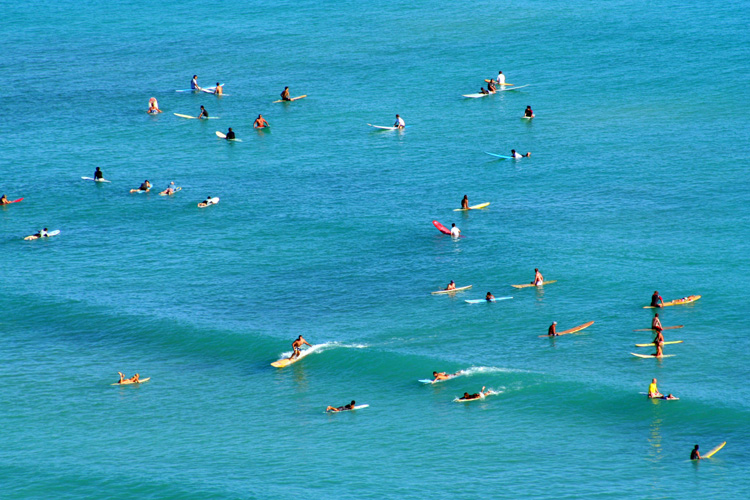Kenneth B. Liberman, Professor Emeritus of Sociology at the University of Oregon, has studied and analyzed the relationships between surfers, the rules of wave riding, and the moral values found in the surf.
"Turn-Taking in the Surfers' Lineup" is one of the most relevant contributions to the knowledge of wave scarcity, surf etiquette, and the corresponding effects on surfers.
Surfing is facing a crisis as the number of surfers keeps rising in every country, leading to overcrowding at surfing breaks.
Rides are becoming scarcer, even while the spirit of surfing remains resistant to being governed by rules that might alleviate the situation.
An Italian sociologist, Ugo Corte (2013: 25), describes this resistance to rules and writes, "Activities such as surfing, skateboarding, snowboarding, and BMX [have] been labeled 'lifestyle sports' because an ethos of anti-competitiveness, anti-regulations, high risk, personal freedom, and artistic expression differs from traditional mainstream sports."
Surfing is unlike many organized sports in that no official is present to call violations, assign penalties, distribute turns, or allocate rights; the surfers must do all of that organizing themselves.
It might be said that surfing is an unorganized sport, but it is not disorganized.
Wave after wave, set after set, somehow someone obtains a ride, collisions are avoided, and the chaos is only apparent.
What is going on in the lineup? How do people get a turn? Are there rules, and if so, what are they? Even more importantly, what are rules, after all?
The problem of turn allocation in surfing can provide us with a naturally occurring opportunity to study what rules really are.
Rules are not as straightforward as we usually think. Rules are always "tangled" in local circumstances (Garfinkel 2002: 65), and the local contingencies of each moment complicate any straightforward, common-sense application of rules.
We need to think more originally about what rules really are. Surfers know better than that, and so should we.
As surfing gets more overcrowded, these questions are of interest not only to sociologists but to surfers, and surfing publications have been analyzing the rules and the moralities of the lineup in order to shed light on the phenomenon of turn-taking in the lineup, but their analyses fall short of identifying and describing what is really going on.
Overlapped Rules
Because the phenomenon of order in surfing is very dense and does not emphasize the rationale, we don't want to make our description more abstract than it is.
There are rules in surfing.
In fact, one of the difficulties is that there are too many rules, and the problem is that they overlap; on occasion, it is unclear which rule should be applied.
The rule that the inside surfer has the right to the wave, which in the sign is the topmost rule: "Don't drop in," must compete with other rules that direct that the first person to stand up has a right to the wave or that the surfer in the best position to get the best ride that the wave affords (especially if that surfer's skill level is higher) has priority.
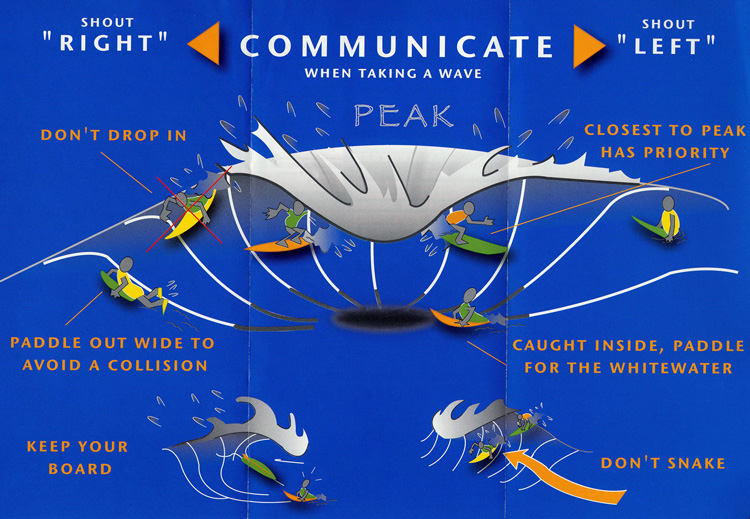
In the face of highly dynamic ocean-generated local contingencies, it is not an easy matter to decide on the rule that is applicable.
Moreover, surfers do not act the way they act because there are rules. They are trying to ride a wave, which is mostly a non-verbal activity.
To a large extent, "rules" are the analyst's abstraction and are something that people mostly think about afterward.
Normally, the situation occurs first, and the rules afterward, as a kind of gloss that might be able to describe what has just happened.
This is contrary to the classical accounts that sociologists give about rules. So what are rules, really? Let's examine some of them.
Generally, no more than two people can ride a wave at the same time.
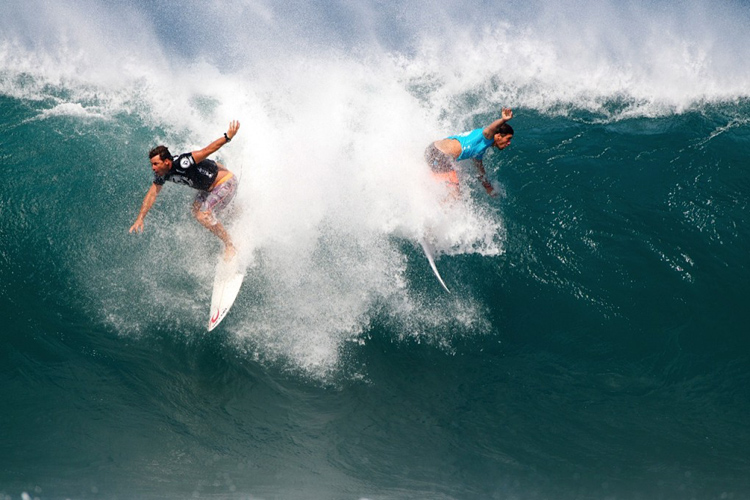
Here is the ideal, where the surfer "inside" cedes the wave to the outside rider:
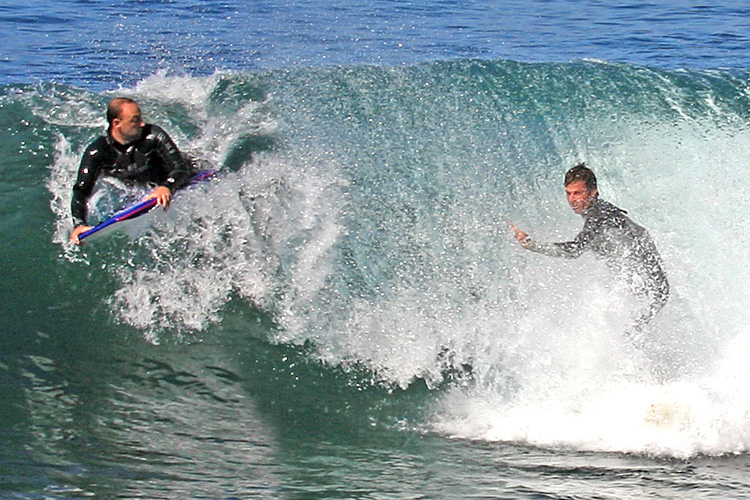
[In some cases] (...) when the waves are large and energetic (...) surfers are paying attention only to the next impending wave and not to each other or to anyone taking off.
They are preoccupied with avoiding being smashed by the wave.
Wave size can affect the way that surfers communicate and organize their actions.
Since situations can be dangerous, a bit of orderliness is needed; local authorities try, but their attempts are somewhat feeble.
General advisories like you see on signs at popular surf breaks are too remote from the situation to make much of a difference.
As crowds increase, and especially with the occasional chaos of shortboarders, longboarders, kayakers, and stand-up paddleboarders (SUPs) surfing together, some surfers have suggested that more formal organization of the order is necessary.
Banning SUPs
Recently, a group of surfers called Safe Surf Hawaii proposed a pilot program meant to ban stand-up paddle surfing at some lineups in Honolulu.
In response to the proposal, the Department of Land and Natural Resources held a meeting where both proponents and opponents debated the issue.
The desire for a ban on SUPs in certain Honolulu lineups three days a week from 3-9 p.m. arose because they believed that SUPs were taking more than their fair share of waves.
SUP supporters argued that the lineups should be self-policed.
The manager of a local surf shop that specializes in SUPs said, "We don't need the government regulating our lineups. For the most part, lineups are self-policing.
If someone is being a wave-hog, whether he's on a SUP or not, the lineup regulates that." Does the lineup regulate that? If so, how does the lineup regulate that?
At the conclusion of the meeting, the government opposed the proposal, and the ban was not implemented.
The opinion at the meeting most frequently expressed was that surfers and SUP users need to regulate themselves.
But it is less than clear just how much "self-regulation" or "self-policing" is supposed to work.
The very name "lineup," which is in common use throughout the world, implies that there is a "line" - that is, an order of turns - but as we know, it is not quite like that. There can be turns, but to some extent, each wave poses a unique situation.
There is a rule that one does not take the first wave when one has just paddled out and others have been waiting.
The signs say, "Give respect to get respect," but that is a very general gloss, and it is more of a recommendation than a rule.
Rules are not the first thing in one's mind as one is gliding through the ocean's forms – one is not thinking about rules; rather, one is snagging sudden opportunities.
Yet there may be rule-governed occasions that are managed locally.
Most people are myopic, caught up only with what is immediately before them, and some special coordination must happen before a rule can be applied successfully.
Rules are occasioned events, inextricably entangled in local circumstances, and so there is no simple rule-governance; rather, rules are resources that can be used for coordinating and concerting some of the activity.
A rule collects an orientation to an episode that can be used by parties to enable sharing of their understanding.
That is, the immediate situation can afford members an opportunity to communicate using the rule as a vehicle.
Surfers will raise a rule only when there is an action that can be clearly attached to the specific rule since it is pointless to assert a rule when the relationship between the rule and action cannot be made publicly visible.
When there is no opportunity for clear communication to occur, most attempts to apply a rule will be abandoned.
Accordingly, what 'violations' end up getting articulated depend less upon the degree of blatant disrespect and more upon the capacity to articulate a complaint in a clear way.
Here, the micro-social structures influence the rule of governance.
How are the moralities that we witness in the lineup made evident by surfers, and under what conditions, and just what is the local work of surfers in making them evident?
Two Australian sociologists who study surfing (Waitt and Frazer 2012: 329) suggest that "Each time a surfer enters the ocean, they must actively negotiate their position within a surfing fraternity and hierarchy."
"Negotiating" is probably too rationalist a term here, but there is a great deal of competition for wave priority for a sport that is supposedly "anti-competitive."
Ethical behavior is connected to the public accountability of a surfer's actions.
In surfing, remorse may be more frequent than ethical behavior, as riding comes first and rule application second.
As surfers know better than most, it is easier to ask for forgiveness than it is to ask for permission.
Let's look at a few more cases.
When Rules Don't Rule
On many occasions, the rule that the outside person has the right to ride is applicable only when the outside rider is persistent about asserting that right.
Sometimes, an inside surfer is already up and riding the wave when the outside person stands up, which can undermine the claim that the outside person has the right to the wave.
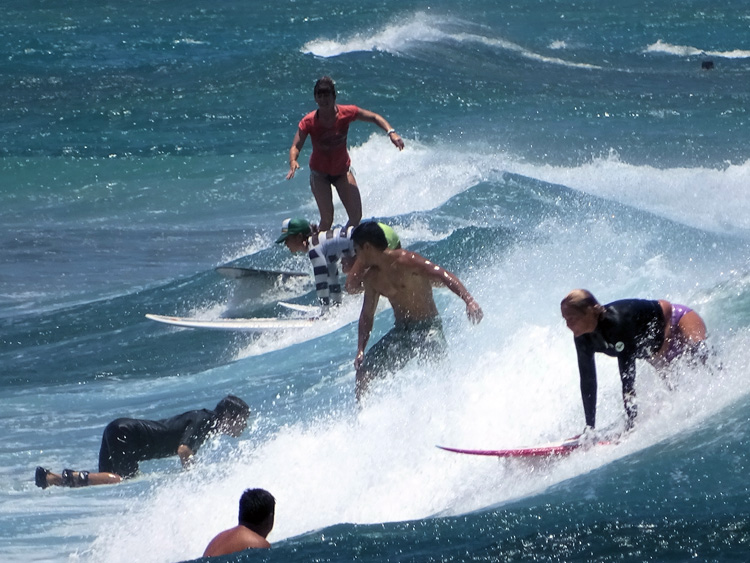
The difficulty is that the rule that the outside surfer closest to the peak has priority is not the only rule.
Surfers with much ability have more rights than surfers with lesser ability, and so one is constantly bidding for a status based on one's performance.
Surfers who are part of a local crew have more rights than newcomers do.
An important policy is that no wave should go unridden, and this is a rule that justifies the aggressive positioning, which at times competes with another rule that everyone should have fun and that no one should spoil "the vibe."
This phenomenon of "the vibe" leads us to mention that surfing cultures differ around the world.
Brazilians are able to ride tandem waves, wave after wave, without feeling they are being molested. They even enjoy sharing waves with their friends.
Americans are more individualistic and prefer having sole rights to a wave. When two asymmetric surfing cultures surf together, there can be problems.
Some surfers and commentators have misunderstood Brazilians' behavior as selfish.
The coordination of order in the lineup is mostly nonverbal and occurs by means of looks and body gestures.
In human relations (and even in relations among apes), looking is a very dense phenomenon.
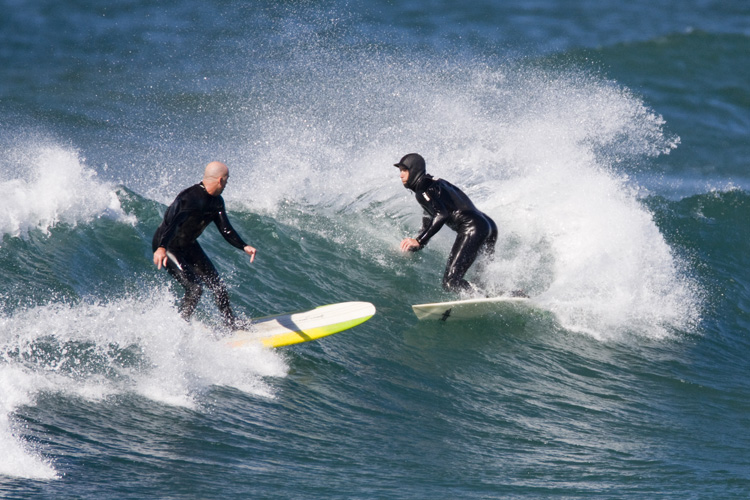
Here, there is a thoroughgoing reciprocal organization, but among surfers, it is very minimalist.
It is minimal because surfers try to avoid looking at each other, even though they are looking at each other all of the time.
When competing for a wave, one must look in order to avoid a collision, but when one does look and see, and more importantly, when one is seen seeing, one acquires a greater responsibility to conform with what rules may become applicable for the reason that one cannot claim to have been unaware.
This is another reason why surfers try to see without looking.
The work done by such non-gazing is subtle and difficult to record and study, as is the case with looking throughout studies of primate societies.
A better understanding of how surfers coordinate their wave sharing may allow us to identify just how the lineup can be self-regulating.
How will surfers develop a solution as the crowd increases? Can they develop a solution without some imposition of order by an external authority?
Words by Kenneth Liberman | Professor Emeritus of Sociology at the University of Oregon
This article is part of a larger project of ongoing research Prof. Liberman is doing with his Spanish colleague Raul Sanchez.
